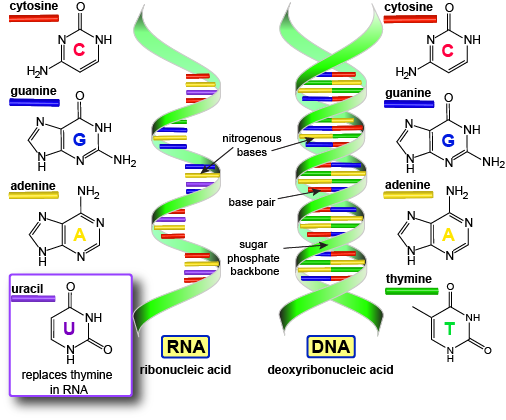The Genetic Code
(A DaVinci Code for Biologists)
You hear about DNA all the time in the news, movies, and a surprisingly high number of Law & Order: SVU episodes. But, do you really know what DNA is? Sure, you hear about it a lot: DNA this, DNA that, blah, blah…blah. You are reading this unit, though, so we will assume that you are looking to learn more. DNA stands for deoxyribonucleic acid (say that five times fast!) and is the basis for life as we know it. Contrary to unpopular belief, deoxyribonucleic acid is not a word that amateur spellers use to show off their spelling skills.In order for something to be a living organism, it must be able to do the following:
- Metabolize
- Grow
- Respond to stimuli
- Reproduce (with or without the aid of Marvin Gaye)
- Adapt to its environment
Nucleic Acids (DNA vs. RNA)
Many of the molecules in a cell are polymers of various smaller molecules. DNA is a polymer of nucleic acids and proteins are polymers of amino acids. You would be a monomer of a conga line polymer. The basic unit for DNA, and its brother RNA (ribonucleic acid), is a nucleotide, also sometimes called nucleobases, nucleosides, or just "bases." Yes, these guys have a lot of nicknames. Nucleotides are also often mistakenly referred to as nucleic acids.
A nucleotide has 3 basic components:
- A phosphate backbone
- A 5-carbon, ring-shaped sugar molecule; it is ribose in RNA, and deoxyribose in DNA
- A nitrogenous base (see the Bases subsection below).

Carbons in ribose are numbered 1', 2', 3', and so on, going clockwise from the oxygen in the ring. DNA and RNA are made from stringing a bunch of these sugars together. We start at the fifth (5') carbon's phosphate group, and new nucleotides added to the polymer at the hydroxyl group on the third (3') carbon. This is why scientists often describe the DNA/RNA sequence based on a 5' to 3' orientation.
Your Starting Lineup...DNA Bases
Life has a do-it-yourself kit to make proteins, with DNA as the warehouse for all the instruction manuals. Yes, there are a lot of instructions. DNA has all the instructions for making thousands of different proteins, and unlike real DIY kits, you are never left with six extra screws with no known purpose.Amazingly, DNA does the job of making thousands of different proteins only using four different letters (A, T, G, and C). Talented? Why, yes! The letters A, T, G, and C stand for four different types of nucleotides:
- A for adenine
- T for thymine
- G for guanine
- C for cytosine

In RNA, thymine is replaced by the base uracil (U). Why is RNA so rebellious, you might ask? We will get to that a little later. If you cannot wait, read the Big Theme on Evolution to find out.
Base Pairing
The bases in nucleic acids are divided into two groups based on the molecules they are most similar to: pyrimidines and purines. Purines have large, double-ringed compounds—guanine and adenine are examples of purines. Pyrimidines have smaller rings—these are cytosine and thymine in DNA, and cytosine and uracil in RNA. A trick for remembering that uracil goes with RNA is to realize that uracil is the only nucleotide with an "r" in its name.These two categories of bases are like the Sharks and Jets (too obscure? How about wolves and vampires?) or some other example of things that always face off against each other. Pyrimidines always bind to purines, and vice versa. Therefore, As bind to Ts (or Us, in RNA), and Gs bind to Cs. This binding is called "complementary" base pairing.

Based on the structure of adenine and thymine versus guanine and cytosine, we can see that there are subtle variations between bonds. A-T bonds are considered weak because there are fewer hydrogen bonds between bases, compared to G-C bonds. That is, A-T has 2 bonds, and G-C has 3. Therefore, G-C bonds are stronger than A-T bonds, and it takes more energy to separate G-C bonds than A-T bonds. If DNA were a school dance, G-C would be the couple that is dancing "way too close," and A-T would be the more polite (reserved?) couple.
DNA vs. RNA
DNA and RNA together comprise all the information in a cell. DNA is typically found double-stranded, where two polymers of nucleotides bind to each other through base pairing (see "Base Pairing"), forming what we call a "double helix."
The two strands are in an antiparallel orientation, meaning that they are aligned head-to-toe in opposite directions. As mentioned in the "Nucleic Acids" section, nucleic acid polymers are read 5' to 3'.While one strand runs 5' to 3' from the top down, the other goes 3' to 5' from the top down. The strands are reverse complements, because the strands are in reverse orientation and are complementary to each other (see "Base Pairing" for explanation), and not because it is a compliment that sounds like an insult.
The fact that DNA molecules are read from the 5' end to the 3' end, and their antiparallel arrangement, are two pretty significant features. They determine how DNA and RNA are synthesized during replication or transcription.
RNA on the other hand, is rarely found in double-stranded forms in a cell. Instead, RNA is a single strand and often has a secondary structure. The primary structure is the sequence of bases. This secondary structure causes RNA to fold by bases binding complementary bases within the same RNA molecule. RNA folding is important for preventing RNA from getting destroyed, and for signaling to stop translation (see "RNA Transcription"). Check this out to see how RNA folds.
Brain Snack
Scientists first found nucleotides by extracting them from natural samples. Adenine, thymine, and cytosine came from glands in the body. Guanine was extracted from sea bird poop. Science once again proves that being a weirdo studying poop is actually a worthwhile pursuit.